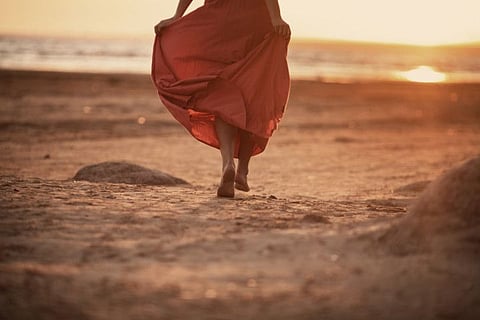Off the cuff: The beauty of walking barefoot
I could feel the ground, feel myself grounded to the earth. I felt liberated

I’ve got quite a big shoe collection. Not anything to rival Imelda Marcos’s, but still, enough and more for my rather humble needs.
Most of my friends too have quite a few pairs — and I’m not just talking of women. Granted, women beat men in the shoe department, but where women have a mix of pricey and not so pricey footwear, things they pick up in a sale or acquire when going through some retail therapy, men go all out for the most expensive footwear they can afford, fewer but more expensive pairs. So it’s actually quits.
Now, walking with shoes is, historically speaking, one of the more recent accoutrements of mankind. Stone-age hunters must have chased their prey barefoot. Perhaps only when they got back to their cave would they warm their toes over a roaring fire.
It seems the first discovered pair of shoes is just over 5,000 years old. However, some anthropologists conclude by looking at toe-bones that the first rudimentary footwear must have been worn around 30,000-40,000 years ago. This is because toe bones became wimpier at this stage, not like the thick, sturdy toe-bones of the previous ages.
Well, let’s leave these messy arguments for the experts to break their heads over.
Also Read: Off the Cuff: In praise of book clubs
Also Read: Off the Cuff: The call of the mountains
Also Read: A paean to the vanishing landline
For most of us, shoes are as important as clothes, or maybe more important. (Remember that saying, that you can judge a person by their shoes?) And walking barefoot seems not just downright difficult, but also something we look down upon. Only the very poor, or hippie-types, go barefoot. The rest of the human population wear some kind of footwear, whether it is of rubber, plastic, suede, leather or any other material. Shoes are items we covet; they not only show our status, but define us, our personalities and tastes.
Many religious shrines require no footwear to be worn. There is a reason behind this. Not only are shoes considered “unclean” as they bring in the outside dirt, but being without footwear frees us in a way from materialism and makes us enter a more spiritual realm. In India, and other parts of Asia too, it is customary to leave your footwear when entering a house.
It’s all very well walking barefoot in a house, or even on grass or sand. But what would you say to going without shoes? Purposely? Sounds a bit crazy, doesn’t it?
Barefoot tourists
Just this summer, I’d visited a small town in South India. I was amazed to see a group of western tourists walking without any footwear around the city, and not feeling an ounce of discomfort! They had truly gone native!
The streets of that city were like any other small city in India, with rough roads and rubbish strewn on the sides. Weren’t they afraid of getting cut by glass, of being pierced by a rusty nail, or, horror of horrors, stepping into a pile of dog-faeces? But no. The group walked down calmly, adroitly stepping over rubbish. In fact, they barely looked down at the ground. Similarly, I noticed how villagers in India walk with barefoot dignity. Couldn’t I do the same?
I tried it for myself. At first, every little stone and the rough surface hurt my tender feet. When I stepped into a rain puddle, I felt disgusted. What kind of germs was lurking inside that dirty pool of water? But after a while, I stopped noticing these minor inconveniences.
I could feel the ground, feel myself grounded to the earth. I felt the warmth of the ground, the cracks in the earth, the mud under my feet.
As my feet covered the earth, one foot at a time, my ego slowly, bit by bit, vanished. I felt liberated. I was one with the universe.
— Padmini B. Sankar is a Dubai-based freelance writer. Twitter: @paddersatdubai
Sign up for the Daily Briefing
Get the latest news and updates straight to your inbox



